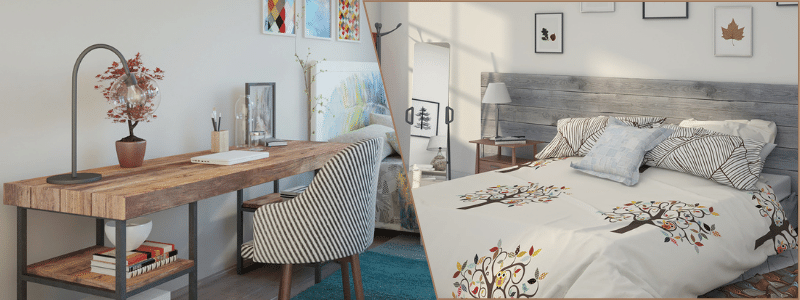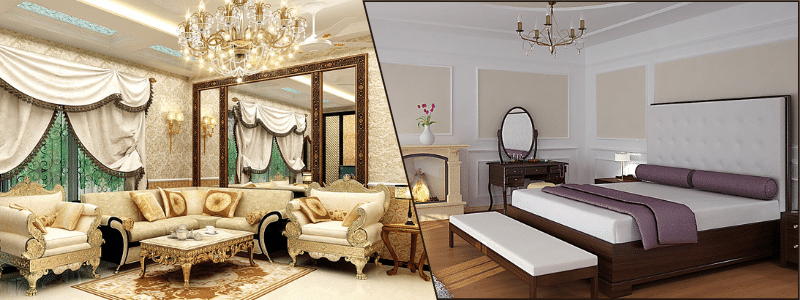3D design and rendering of furniture are now inseparable parts of the home interior industry. Both solutions are found useful not only for marketing purposes but also during the product manufacturing process. Typical services include creating digital 3D CAD models and imagery of furniture pieces such as chairs, tables, cabinetries, and sets of furnishings for specific rooms. Manufacturers can use 3D models to define the specification of furniture products. 3D modeling applies to the design process of furniture in factory-default and personalized-to-order specifications as well.
All information about the shape, dimension, color, material, texture, and finishes are attached to the models. Think of it as a realistic blueprint of the furniture to be manufactured. All details about the furniture exist only in the virtual world during the early design process, so making changes to the design is quick and easy because it is done on screen rather than on a physical object.
Photorealistic images with 3D rendering services
The rendering process will convert those models into photorealistic imagery – fabricated pictures, which then can contribute to marketing content on websites and print materials. Unlike traditional photography that requires finished products to create photos, rendering technology does it all with nothing but virtual 3D assets. There is no physical build-out or setting an array of artificial lighting configurations before capturing the perfect moment.
No matter how complex the scene should be, rendering technology can recreate the desired imagery. Furthermore, rendering makes it possible for manufacturers to showcase their products in 360-degree view or animated footage to help boost sales. Among the advantages is seeing what the furniture will look like when built and placed inside a room before production. Until the time it gets to the manufacturing process, 3D models can be modified and improved to perfection, then rendered to hyper-realistic quality. Only when designers and clients approve the rendered imagery is the product ready to be made.
RELATED: How 3D Furniture Modeling can Drive Your New Product Revenue
How does furniture 3D rendering work
There is nothing fundamentally different between the rendering process of furniture compared with any other product. It all starts by creating the 3D model based on the manufacturer’s requirements. A finished 3D model may not look like physical furniture; it does have a shape and color, but it is pretty plain without any extraneous element.
Additional details are necessary to create photorealistic imagery for example materials, texture, pattern or surface finish, color, and the background. There will be shadows too depending on lighting intensity and direction depicted. Rendering software collects the required data and starts building the imagery. Some of the most popular software and plugins for 3D rendering include Blender, Enscape, V-Ray, Rhinoceros, 3ds Max, Cinema 4D, Revit, and Maya to name a few.
In-house or outsourced 3D rendering?
Unless you work in a big furniture company with more than enough resources for research and development, chances are the rendering process is outsourced to an external service. It is not the kind of work that anybody can learn overnight. You need a skillful artist to create a convincingly realistic render in a relatively short time, and assuming there is no existing 3D model ready to use, the artist has to create it first. Most companies are not well-equipped to do an in-house rendering.
A better alternative is to outsource the work to an external provider, especially if you have to complete the design process in a hurry. Rendering services have professionals with expertise in 3D modeling and experience with computer-generated imagery to get the job done in good quality. Not all rendering services are equal. Find one that specializes in architectural rendering and with a reasonably diverse portfolio in interior design. There are plenty of them out there offering their services at competitive prices.

3D Rendering services make you faster
There are many factors that can potentially improve the chances of a company’s success in the current competitive business landscape. One of them is speed to market, which unfortunately remains a much-undervalued concept. The sooner a company can send new products to store shelves, the more likely it is to attract buyers. Sometimes even inferior quality furniture can outsell better counterparts if the latter fails to reach the consumers quickly. Although this is not to say that quality is any less important, you should never underestimate the potential advantage you may gain from a speedy launch. Since the design process is the most time-consuming part of a product launch, here is how rendering services help you hasten it.
Scrutinize technical details prior to production
One thing that makes 3D rendering a time-saving endeavor is the virtual nature of the process. Working with virtual assets allows manufacturers to sort out imperfections before production begins, therefore eliminating the risk of mistakes that may call for any significant redesign. Rendering services deliver photorealistic imagery based on which everyone involved in the project can clearly see the defined goals. It is important to have a good understanding of the technical aspects of the furniture, including the shape, materials, dimensions, colors, and textures.
Photorealistic imagery gives a pretty good idea of how those elements combine into one feasibly manufactured and marketed furniture. Changes or corrections can be quickly made to the 3D models and rendered images to avoid scraping any progress at later phases of production, hence shortened turnaround time.
Streamline communication
Designers, engineers, and manufacturers do their collaborative works using the same design guidelines provided by the rendered image of the furniture. The absence of conflicting references eliminates communication errors and, at the same time, offers a set of unified instructions on how the furniture should be constructed. Every intricate detail, curve, color shade, and ornamentation look better thanks to good visualization.
Most usable POVs
The most ideal photorealistic rendering during the design process should be in a 360-degree view. When speed is of the essence, it is possible to achieve the same result with a limited number of points of view instead. As long as the selected POVs can cover all parts of the furniture design in workable angles, the manufacturer should find no problem understanding the product. Creating a 360-degree view is more resource-demanding in terms of labor, time, and money compared to several POVs combined. Choose the POVs carefully to highlight the right positions so the job is done faster without affecting visibility.
During the design process, you don’t need a fancy background anyway. Plain white or black backgrounds can in fact highlight the details better than a complex one. The imagery is used as a reference for prototyping or manufacturing, not for marketing purposes. It is easier for the rendering artist yet you get the much-needed detailed product overview to speed up the design process. Furthermore, the price will be more affordable to cut production costs as well. When the time comes to use the image as marketing material, it is not that difficult to insert computer-generated complementary elements.

Pre-rendered backgrounds
Assuming the furniture to be manufactured features a fresh design with details unlike any other in the existing products line or the market in general, a new 3D model is required. Perhaps you can find 3D assets from online sources, but that means you don’t have an original design. Drawing a 3D model from scratch takes a reasonable amount of time, so you have to find ways to compensate for it. While you may not be able to use pre-rendered 3D models, no one says you cannot benefit from pre-rendered scenes. Extraneous elements in the background set including decorations and the room itself never have to be completely original.
You are making the furniture, not designing the entire interior space. This is why working with experienced rendering services can help a great deal. They most likely have ready-made digital props and backgrounds from previous projects. If you modify crucial elements like lighting, shadow, or color schemes, the finished imagery will look brand new. Give some tweaking to the viewing angle, and your furniture is still properly the focal point in the frame.
Design flexibility
Anything versatile, adaptable, easily modified, and flexible is almost always good for business. In the furniture design industry, all those characteristics exist in 3D models and rendering. It is good to have a product blueprint that allows you to make quick affordable changes for design improvement. The general idea of 3D rendering is to add a new level of flexibility to the design process. Every image is composed of multiple design ideas poured into a single visualization.
The company doesn’t have to produce a physical prototype for every new upcoming product. Instead, they can have mockups created by an outsourced rendering service. Moreover, the company has a large window to discover any design flaw or mistake during the early phase of the design process, and correct them digitally.
RELATED: How 3D Modeling Can Cut Costs in the Furniture Market
Accurate product visualization
The furniture featured in the rendered imagery must be an accurate representation of the actual product. Any good rendering service can create digital mockups of furniture in front of plain background or complex realistic scenes. However, the finished rendering is only as accurate as the manufacturer describes it in the first place.
Clear instructions, detailed specifications of the product, desired POVs, room atmosphere references, and all other additional elements must be unambiguously defined. Otherwise, the imagery may come with a lot of mistakes too cumbersome to repair that you need to completely restart. Many rendering services offer reasonable revision, but it is always better to get the job done right the first time.
The furniture design industry has gained some great benefits from rendering services. Precise high-resolution computer-generated imagery provides easy-to-understand visualization of an otherwise abstract concept, unlimited customization, and efficiency improvement without disrupting progress. All in all, rendering services accelerate the design process to help manufacturers win the race to send products into the hands of consumers.
How Cad Crowd can help
Whether you are a small business or working in a large company, Cad Crowd can assist in connecting you with one of our vetted designers for a variety of 3D rendering projects! Tell us your budget, and a few details of what you are hoping to achieve and we’ll handle the rest. Get a free quote today!
